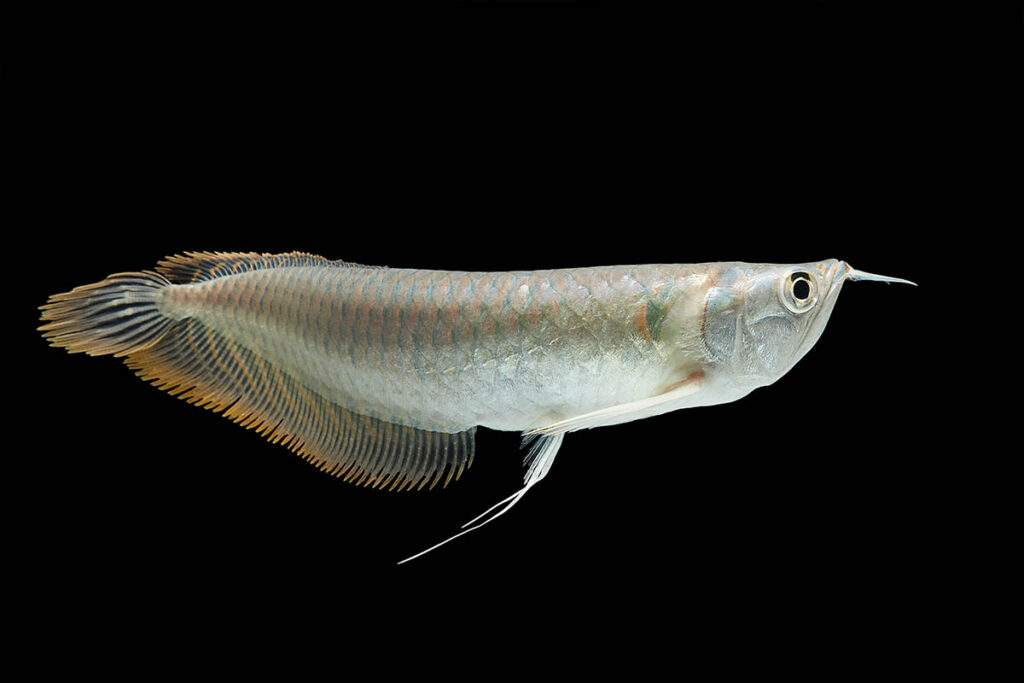
Discover how to care for Arowanas—from tank size and species differences to diet, tank mates, and insider tips for a thriving, graceful swimmer.
Watching an Arowana glide across the water is like seeing a miniature dragon patrol its domain. Their sleek scales, powerful fins, and elevated elegance make them unforgettable tank residents. But caring for one takes dedication, space, and respect—they’re not pets for the casual hobbyist.
Quick answer: Arowanas are large, predatory freshwater fish requiring massive aquariums, pristine water, a varied carnivorous diet, and a secure, solitary setup to thrive.
Understanding Arowana Species, Size & Lifespan
Arowanas are bony-tongue fish—including Asian, Silver, Black, Jardini, and Leichardti types. Most reach 2–3 feet in captivity; some can stretch up to 4 feet in the wild. These living antiques can live 10–20 years, even past 20 years in ideal settings.
Asian varieties like the Asian Arowana can grow up to 90 cm (about 3 ft) and require specially tailored habitats.
Tank Size & Layout Essentials
Tank Volume & Shape
Arowanas need massive space. A juvenile might start in 150–250 gallons, but full-grown adults need 300+ gallons—a barely sufficient minimum for a 3-foot fish. For serious keepers, tanks of 400–500 gallons or more with large open surface areas and ample length are ideal .
The tank should be long and wide—height is secondary. This gives your Arowana room to glide and perform its signature surface hunting behavior.
Lid & Decor
These fish are notorious jumpers—some have leapt over 6 feet to snatch prey from branches. A solid, leak-free lid is non-negotiable.
Keep decor minimal for open swimming space. Driftwood or low-profile structures can be added for aesthetics, but avoid blocking their path.
Water Conditions & Maintenance
Temperature & Chemistry
Maintain 75–82°F (24–28°C), with pH around 6.5–7.5 and soft to moderate hardness. Water must be immaculately clean—Arowanas are extremely sensitive to poor conditions.
Filtration & Water Changes
Expect to perform 20–50% weekly water changes and use robust filtration and circulation systems to ensure oxygen-rich, stable water.
Feeding & Diet
These are true carnivores. Juveniles thrive on live food like feeder fish (quarantined!), shrimp, or insects. As they mature, high-quality floating pellets and meaty frozen foods (krill, shrimp, earthworms) help avoid disease and maintain variety.
Feed 2–3 times daily as juveniles, reducing to 1–2 times as they age. Avoid overfeeding—only offer what is eaten in a few minutes.
Tank Mates & Behavior
Solitary Nature
Arowanas are mostly solitary. Adults are territorial and may attack others—even their kind. They’re best kept alone unless you have a massive tank with similar-sized companions introduced early.
Possible Companions
If you do attempt companions, choose large, calm species that won’t fit in their mouth:
-
Large Plecos
-
Oscars
-
Pacus
-
Catfish (e.g., redtail catfish)
-
Datnoids, Gar, Knifefish.
Always closely observe introductions, as individual temperaments vary.
Behavioral Health & Common Issues
Droopy Eye
Arowanas often develop “droopy eye” from looking downward for food. You can mitigate this by encouraging surface feeding with floating objects or reflective feeding spots.
Jumping Hazards
They are surface hunters and can jump unexpectedly. Avoid reflective lighting or external movement that may startle them.
Disease Sensitivity
They’re prone to fungal infections, ich, parasites, and scale issues—ensure strict quarantine for new additions and maintain pristine water to prevent these.
Breeding Behavior
Arowanas are mouthbrooders. Males (and some Asian/Australian species) carry eggs and fry for weeks—though breeding is extremely rare in home aquariums due to size, aggression, and space constraints.
Common Questions (FAQ)
How big do Arowanas get?
Typically 2–3 feet in captivity; some may reach 4 feet.
How long do they live?
Up to 20 years with proper care.
What tank size is required?
Minimum 300 gallons for adults; ideally 400–500 gallons or more.
What water conditions do they need?
75–82°F, pH 6.5–7.5, soft-moderate hardness, flawless water quality.
What do they eat?
A variety of meat-based food: live feeds, frozen shrimp, prawns, pellets; occasional insects.
Can they live with other fish?
Rarely—solitary is best. Any tank mates must be large, peaceful, and tank-appropriate.
My Personal Tips & Reflections
When I first set up for an Arowana, I underestimated the space it would need. Upgrading to a longer tank (5+ ft) changed everything—it gave the fish room to cruise, fed surface pellets without conflict, and minimized jumping risks.
Floating feeders and reflective decor help keep feeding interesting and reduce droopy eye. Maintenance became manageable once I upgraded filters and reduced stressors like bright lighting and high traffic around the tank.
Conclusion – Is an Arowana Right for You?
Caring for an Arowana is a commitment worthy of respect. They demand space, precision, and patience. But when done right, you’ll witness a creature that moves with regal grace—capturing attention and bringing awe into any room.
If you’re ready for the responsibility, Arowanas can reward you with decades of beauty and behavior that dazzles.
